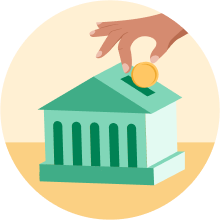
» Want to see more options? Check out our list of the best CD rates overall
What is a 1-year CD?
A one-year CD is a type of savings account that keeps a fixed sum inaccessible for 12 months and locks in the APY (your rate of return). If you pull the money out early, you’ll typically have to pay an early withdrawal penalty. A regular savings account, on the other hand, has a variable rate, meaning the interest rate can change over time but you can pull your money out at any time. (You can find even shorter terms, such as six-month CDs.)
Best 1-year CD rates for July 2024
-
BMO Alto: 5.05% APY, no minimum to open.
-
Bread Savings: 5.25% APY, $1,500 minimum to open.
-
Popular Direct: 5.20% APY, $10,000 minimum to open.
-
Bask Bank: 5.30% APY, $1,000 minimum to open.
-
TAB Bank: 5.15% APY, $1,000 minimum to open.
-
Barclays: 5.00% APY, no minimum to open.
-
Alliant Credit Union: 5.05% APY, $1,000 minimum deposit.
-
Service Credit Union: 5.00% APY, $500 minimum deposit.
-
LendingClub Bank: 4.40% APY, $500 minimum deposit.
-
Connexus Credit Union: 4.91% APY, $5,000 minimum deposit.
-
Vio Bank: 5.00% APY, $500 minimum deposit.
-
Ivy Bank: 5.00% APY, $1,000 minimum deposit.
-
Andrews Federal Credit Union: 4.89% APY, $1,000 minimum deposit.
-
Citizens: 5.00% APY, $5,000 minimum deposit.
-
CIBC U.S.: 5.21% APY, $1,000 minimum deposit.
-
Capital One: 5.00% APY, no minimum deposit.
-
Marcus by Goldman Sachs: 5.15% APY, $500 minimum deposit.
-
Sallie Mae Bank: 5.15% APY, $2,500 minimum deposit.

1-year CD trends
NerdWallet picks’ average:
5.11% APY
1.86%
💬 Our Nerds say:
“One-year CDs are unusually competitive right now. Their best rates surpass three- and five-year CD rates. And, compared to high-yield savings accounts, one-year rates remain higher.
“Because of one year CDs’ popularity, you can be more choosy about the institution you want to leave your money with. Personally, I like to have a high-yield savings account at the same place I have a CD to make the maturity process easier.”

How to find the best one-year CD for you
Compare these four factors:
-
APY: This is the annual percentage yield, which is your rate of return that includes having interest compounded.
-
Minimum deposit: This is the lowest amount you need to open a CD, but you generally don’t want to use the minimum as a guide for the right amount to save in a CD. Learn more about how much money to put into CDs.
-
Early withdrawal penalty: It’s good to know the cost of the worst-case scenario where you break the seal on your CD early. See what typical penalties cost.
-
What else you want from that institution: Do you want a checking or savings account at the same place you get a CD? Not all banks offer all these types of accounts. Are you focusing on CDs where you bank or where you’re an investor? CDs at banks (and share certificates at credit unions) can be easier to manage, unless you’re familiar with the ins and outs of a brokerage account and want brokered CDs.
Why are one-year CDs so high right now?
One-year CD rates are high largely thanks to two big reasons:
-
The Fed rate has remained high and mostly unmoving for the past year. This rate plays a big role in how banks decide to adjust their CD rates (and how credit unions do the same for their share certificates).
-
CD rates can reflect banks’ attitudes about where rates are headed. In the current rate environment, one-year CD rates are generally higher than longer-term rates, such as for three or five years. This shows how banks believe rates will fall sooner than later. Learn more about the factors that impact bank account rates in mid-2024.
Alternatives to 1-year CDs
Here’s a list of other short-term savings options:
-
Other short-term high-yield CDs: The best three-month and six-month CDs have strong rates and can help you build a short CD ladder, which can be made of CDs with terms of three months, six months, nine months and one year. For this short ladder, a CD matures every three months, at which time you can either cash out or reinvest in a new one-year CD as the longest term of the ladder.
-
No-penalty CDs: These specialty CDs usually have terms around one year and let you withdraw the full amount early at no cost. Rates can be lower than high-yield CDs, though.
What’s involved in opening a CD?
You’ll need to decide on what term and type of CD to get and whether to open a single or joint account. To see all five steps, check out this guide to opening a CD account.
Are CDs safe?
Yes, CDs are safe as long as they’re issued by institutions that have federal deposit insurance. Most banks and credit unions insure your money in a CD up to $250,000 per person, per account type — such as single-owned and joint accounts. Plus, your returns are guaranteed as long as you don’t withdraw early, in which case you may have to pay a penalty. For more details, see our article on the safety of CDs.
No-penalty CDs offer more freedom
When you withdraw your money from a CD before the term expires, you generally pay a penalty of at least several months of interest earned.
Some providers, however, allow you to withdraw your money before the term expires, with no penalty. Keep in mind that rates may be a little lower for these no-penalty CDs.
The following three banks offer no-penalty CDs (click each link to read the full review):
See CD rates by term and type
Compare the best rates for various CD terms and types:
How do CDs work?
Learn more about choosing CDs, understanding CD rates, and opening and closing CDs.





